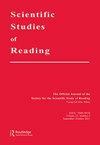Morphological Effects on Orthographic Learning in Monolingual English-Speaking and Bilingual Chinese-English-Speaking Children
IF 2.4
2区 教育学
Q1 EDUCATION & EDUCATIONAL RESEARCH
引用次数: 0
Abstract
ABSTRACT Morphological knowledge is known to be positively associated with reading ability. However, whether morphological knowledge affects children’s learning of new orthographic representations is less clear. Purpose This study aimed to investigate morphological effects on orthographic learning in English, and whether this effect, if any, is different for monolingual compared to Chinese-English-speaking bilingual children, who often have difficulty acquiring English inflectional morphology. Method 59 Year 2 children, including 29 English-speaking monolinguals and 30 Chinese-English-speaking bilinguals participated. We assessed children’s preexisting English inflectional morphological knowledge. The children learned twelve novel words that were either presented with morphological variation (e.g., vack, vacks, vacking, vacked) or pure repetition (e.g., vack x 4). Orthographic learning was measured by orthographic choice and spelling tasks. Results 1) orthographic learning from the spelling task showed better performance in the repetition condition, 2) there were no differences in orthographic learning between the monolinguals and bilinguals, despite the fact that the monolinguals had better inflectional morphological knowledge than the bilinguals. Conclusion Children learned novel written words better when they are presented without morphological variation, supporting the item-based feature of the self-teaching hypothesis. Chinese-English-speaking bilinguals’ weaker English morphological knowledge does not seem to hinder their orthographic learning ability.形态对英语单语和中英双语儿童正字法学习的影响
本文章由计算机程序翻译,如有差异,请以英文原文为准。
求助全文
约1分钟内获得全文
求助全文
来源期刊

Scientific Studies of Reading
Multiple-
CiteScore
7.20
自引率
2.70%
发文量
26
期刊介绍:
This journal publishes original empirical investigations dealing with all aspects of reading and its related areas, and, occasionally, scholarly reviews of the literature, papers focused on theory development, and discussions of social policy issues. Papers range from very basic studies to those whose main thrust is toward educational practice. The journal also includes work on "all aspects of reading and its related areas," a phrase that is sufficiently general to encompass issues related to word recognition, comprehension, writing, intervention, and assessment involving very young children and/or adults.
 求助内容:
求助内容: 应助结果提醒方式:
应助结果提醒方式:


